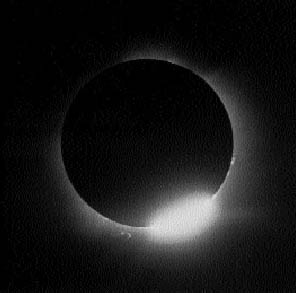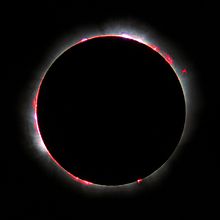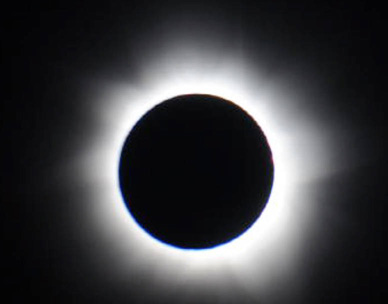Steve Cable considers the question of why we could possibly be important in such a vast universe. Current research shows that there are reasons why God needed such a vast universe to house life on this planet. Understanding this idea can make it an apologetic for our faith rather than a fact which detracts from our faith. Science is the study of God’s creation and the more we delve into it the clearer the hand of God becomes.
Why Is the Universe So Vast? Are We Truly Insignificant?
What do you feel when you look at the night sky? Awe? Insignificance? Adoration? Recently, my wife and I took three Ph.D. students from China for an overnight outing at a lake in West Texas. One of the things that impressed them most was the opportunity to view the night sky on a moonless night. Due to “light pollution,” people in most cities can only make out a few hundred stars with the naked eye. These young women had never seen the night sky as King David did when he declared, “The heavens declare the glory of God!” (Psalm 19:1, NASU). They were so taken by the stars and the Milky Way that they spent several hours lying on the dock, looking up at the night sky.
 These students were not Christians, and I was glad to have an opportunity to use what we know about the stars to talk to them about the overwhelming evidence for a Creator who is intensely interested in humans. However, another host may have used the same night sky to argue that if there is a God, we must not be very significant to God. Which view is correct? In this article, we will look into the Bible and into current scientific theories to better equip us to answer this important question.
These students were not Christians, and I was glad to have an opportunity to use what we know about the stars to talk to them about the overwhelming evidence for a Creator who is intensely interested in humans. However, another host may have used the same night sky to argue that if there is a God, we must not be very significant to God. Which view is correct? In this article, we will look into the Bible and into current scientific theories to better equip us to answer this important question.
According to the Bible, the transcendent Creator of this universe made humans in His own image as the focal point of His creation. Skeptics of a biblical worldview often point to the vastness of the universe as evidence that humans cannot be the focal point of a theistic creation. The famous astronomer, author, and television personality Carl Sagan put it this way:
Our posturings, our imagined self-importance, the delusion that we have some privileged position in the Universe, are challenged by this point of pale light. Our planet is a lonely speck in the great enveloping cosmic dark. In our obscurity, in all this vastness, there is no hint that help will come from elsewhere to save us from ourselves.{1}
Famous physicist Stephen Hawking wrote, “Our Solar System is certainly a prerequisite for our existence . . . . but there does not seem to be a need for all these other galaxies.”{2}
In other words, why would God create this huge universe, if He was primarily interested in His relationship with one species occupying a tiny planet?
I think this is a reasonable question. After all, based on observations from the Hubble Telescope, the current best estimate for the number of stars in the observable universe is 5 times 10 to the 22nd power; that is a 5 with 22 zeros after it. How many stars is that? Well, if you were to count one star every second, it would take you only fifteen hundred trillion years to count them. These stars are spread over billions of light years. Amazingly, all of these stars account for only about 1% of the total mass of the universe. Why did God create such a vast universe, placing us on a single small planet with no reasonable hope of ever traveling beyond our solar system? Does the size of our universe run counter to a biblical worldview?
A Biblical Perspective of Humankind and the Vast Heavens
If God is the Creator of the universe, and the Bible is revelation directly from God, then accurate observation of the universe will ultimately prove to be consistent with His revelation. By combining the general revelation of science with the special revelation of the Bible, we should be rewarded with a greater understanding of the nature of our Creator and His intentions for mankind. Let’s see if this is true in addressing the vastness of the universe.
First let’s consider what God’s special revelation for us, the Bible, has to say about the vastness of the universe. The Bible often refers to God’s creative work in “stretching out the heavens” and filling it with stars (e.g. Job 9:8, Zechariah 12:1). A review of Bible passages on the stars and the heavens reveals a number of reasons why a vast universe is consistent with humans being the most significant part of creation.
We need to realize that creating a vast universe is not harder for God than creating a smaller universe. God brought the universe into existence out of nothing. He had no limits on the amount of matter and energy created. Consequently, it is meaningless to say that it would be a tremendous waste for God to create so many lifeless galaxies. The concept of waste only applies when there is a limited supply. When there is an unlimited supply, you can use all you desire; there is plenty more where that came from.
Within this vast universe, God placed earth in potentially the only place in the universe capable of supporting advanced life. There are many aspects of the universe that are hidden from the casual observer, but the vastness of the heavens is not one of them. God created the earth and positioned it in an ideal place so that humans could observe the vastness of the heavens and the enormous number of stars. The Bible points out at least five purposes for humans observing this vast universe:
1. To reveal His majesty and power. Job refers to this understanding as he reflected on his sufferings stating,
Who commands the sun not to shine,
And sets a seal upon the stars;
Who alone stretches out the heavens
And tramples down the waves of the sea;
Who makes the Bear, Orion and the Pleiades,
And the chambers of the south;
Who does great things, unfathomable,
And wondrous works without number.
Were He to pass by me, I would not see Him;
Were He to move past me, I would not perceive Him.
Were He to snatch away, who could restrain Him?
Who could say to Him, “What are You doing?” (Job 9:7-12).
Later, God confronts Job with His lack of understanding the full power and majesty of His Creator:
Where were you when I laid the foundation of the earth?
Tell Me, if you have understanding, . . . .
Can you bind the chains of the Pleiades,
Or loose the cords of Orion?
Can you lead forth a constellation in its season,
And guide the Bear with her satellites?
Do you know the ordinances of the heavens,
Or fix their rule over the earth? (Job 38:4, 31-33).
As we see in this passage, God intentionally did creative, wondrous works without number so that we could glimpse His greatness.
2. To emphasize our insignificance without God. The vastness of the heavens highlights how insignificant humans are apart from God’s concern for us. The primary lesson that Job learned through his experience was that we are in no position to critique God’s actions over His creation. God’s creation is so vast that any significance we have comes solely from God’s choice to be concerned with us. Job stated it this way: “Behold, I am insignificant; what can I reply to You?” (Job 40:4)
King David was the most significant person in Israel during his reign, but when he considered the vastness of God’s creation he acknowledged our insignificance:
When I consider Your heavens, the work of Your fingers,
The moon and the stars, which You have ordained;
What is man that You take thought of him,
And the son of man that You care for him (Psalm 8:3-4)?
3. As a measure of His loving kindness toward us. God uses the vastness of the heavens to help us understand the magnitude of His love for us, stating, “For as high as the heavens are above the earth, So great is His loving kindness toward those who fear Him” (Psalm 103:11).
God’s love for us is greater than the billions of light years which separate us from the most distant galaxies.
4. As a picture of His faithfulness and forgiveness. In a similar way, God uses our inability to completely grasp the breadth and depth of the universe to emphasize spiritual truths. Through Jeremiah, God promised a new covenant where He will remember our sins no more. God used the vastness of the heavens to convey His promise to never cast those in the new covenant away from Him with these words,
Thus says the LORD, “If the heavens above can be measured
And the foundations of the earth searched out below,
Then I will also cast off all the offspring of Israel
For all that they have done,” declares the LORD (Jeremiah 31:37).
Even today astronomers recognize that the universe we can observe is much smaller than the state of the universe as it exists today. Due to the finite speed of light, it is impossible to directly observe the current size of the universe or count the exact number of stars. Just as the heavens can never be measured, God will never cast us off from His presence.
5. As a reminder that our understanding is limited. Our Creator understands the universe from one end to the other and from the beginning of time to its end. As humans, we are just beginning to probe its mysteries. So, God reminds us, “For as the heavens are higher than the earth, So are My ways higher than your ways And My thoughts than your thoughts” (Isaiah 55:9).
It is clear that God intended us to observe and study the stars and the heavens. As a part of God’s general revelation, the magnitude of the universe speaks to His greatness. Through God’s special revelation, we see God using the vastness of His creation to teach us lessons about who we are and how we relate to Him. For a Creator who was willing to sacrifice His only Son on the cross for our redemption, it would be child’s play to create a vast universe solely for our instruction. With this understanding, the vastness of the universe becomes a testament to our importance to God rather than evidence of our insignificance.
A Scientific Perspective of Humankind and the Vast Universe
If God is the Creator of the universe and the author of the Bible, accurate observation of the universe will ultimately prove to be consistent with His revelation. By combining the general revelation of science with the special revelation of the Bible, we should be rewarded with a greater understanding of the nature of our Creator and His intentions for mankind.
In his book Why the Universe is the Way It Is{3}, Hugh Ross points out a number of areas where combining the latest observations of astronomy and physics with biblical theology provides us with fuller answers for some of the tough questions of life. One area he focuses on is the question we have been examining: “Does the vastness of this universe mean that we are insignificant and/or accidental?”
If we assume, as most skeptics and seekers would, that the physical laws of this universe have remained constant from the beginning of the universe until now, then the current state of scientific knowledge points to three reasons why the universe must occupy the mass and volume that it does in order for advanced carbon based life to exist on this planet.
1. The exact mass of the universe was necessary for life supporting elements to exist. Life requires heavier elements such as oxygen, carbon, and nitrogen. These elements are produced in the nuclear furnaces of stars. If there were less mass in the universe, only lighter elements such as helium would be produced. If there were more mass, only heavier elements, such as iron, would be produced. In fact, the amount of mass and dark energy in the universe must be fine tuned to less than one part in 10 to the 60th power, or one part in one trillion trillion trillion trillion trillion, to have a universe that can create a life supporting solar system and planet.
2. The exact mass of the universe was required to regulate the expansion of the universe to allow the formation of the sun and the solar system. Amazingly, it turns out that the same total mass that results in the right mix of life supporting elements also results in the right amount of gravity to dampen the expansion of matter across the surface of the space-time continuum to allow the formation of stars like the sun which are capable of supporting a planet like earth. If the universe were expanding faster, stars and solar systems would not form. If the universe were expanding slower, giant stars and black holes would dominate the universe. Once again the total matter in the universe is fine tuned to support life. And what an amazing coincidence: the number that creates the right mix of elements also creates the right expansion rate. This dual fine tuning is much less likely than achieving the financial returns guaranteed by Bernie Madoff!
3. The vast volume of the universe is required to give the earth just the right amount of light and other electromagnetic radiation to support life and not destroy it. Life not only requires a planet with the right mix of elements orbiting the right kind of sun in just the right solar system; it also requires a “just right” galactic environment. Astronomers has discovered what they call “the galactic habitable zone” for our Milky Way galaxy at a distance of about 26,000 light years from the center of the galaxy. Any planet closer to the center will experience deadly radiation levels. Any planet further away from the center would lack the mix of heavy elements necessary for advanced life. But the vast majority of this habitable zone is inside one of the uninhabitable spiral arms of the galaxy. Since stars revolve around the galactic center at a rate different than the spiral arm structure based on their distance from the center of the galaxy, most solar systems pass through deadly spiral arms over the course of time. Our solar system occupies a very special place as Hugh Ross points out: “The solar system holds a special position in the Milky Way . . . the one distance from the core where stars orbit the galaxy at the same rate as its spiral arm structure does.”{4}
Once again we are faced with a divine “coincidence”: the same fine-tuned distance required to safely place a habitable planet is also the exact distance required to keep that planet out of the deadly spiral arms.
Not only must the earth be located far from the center of the Milky Way, the Milky Way must be located far enough away from other galaxies to maintain the stability of its spiral structure. Many aspects of the Milky Way appear to be very rare or unique in the universe.
As you can see, a logical application of current scientific orthodoxy based on the Big Bang and constant natural laws overwhelmingly supports the view that the vastness of the universe does not imply that human life is unremarkable and insignificant. On the contrary, the most reasonable conclusion from the evidence is that life on this planet is the primary purpose behind the vastness of our universe. Both the Bible and the results of scientific observation agree: our vast universe is the work of a Creator who considers life on earth as very significant.
Consequently, we don’t have to convince a seeker that the world is much younger than it appears in order to answer the question, “Are we significant to our Creator?” We can say, “Whether you look to the teaching of the Bible or you look at the current prevailing models from the scientific community, the answer is definitely yes!” The important question is, “Is it possible to know more about my Creator and have a relationship with Him?” Beginning with the death and resurrection of Jesus, we can explain how to have an eternal relationship with God and why we believe the Bible is the reliable source of information about our Creator and our universe.
• Check out our article “The Answer is the Resurrection” at Probe.org for more information on using the resurrection to respond to key questions from seekers.
• For more information on topics related to the origins of our universe and other science topics, check out our Faith and Science section.
• For further discussion on the age of the universe see “Christian Views of Science and Earth History” in our Faith and Science section.
• For further discussion of how the age of the universe debate relates to this discussion see Appendix A: Theology vs. Science or Theology plus Science? and Appendix B: Apologetics and the Age of the Universe.
Notes
1. Carl Sagan, Pale Blue Dot: A Vision of the Human Future in Space (New York: Random House, 1994).
2. Stephen Hawking, A Brief History of Time: From the Big Bang to Black Holes (New York: Bantam, 1988).
3. Hugh Ross, Why The Universe Is The Way It Is (Grand Rapids, MI: Baker Books, 2008).
4. Ross, Why The Universe Is The Way It Is, 66.
© 2009 Probe Ministries
 During an eclipse, the heavens declare the glory of God by allowing us to see things about the sun we wouldn’t be able to observe any other way, beautiful and gloriously resplendent. Just before totality we can see “Baily’s Beads.” Only seen during an eclipse, bright “beads” appear at the edge of the moon where the sun is shining through lunar valleys, a feature of the moon’s rugged landscape. This is followed by the “diamond ring” effect, where the brightness of the sun radiates as a thin band around the circumference of the moon, and the last moments of the sun’s visibility explode like a diamond made of pure light. After the minutes of totality, the diamond ring effect appears again on the opposite side of the moon as the first rays of the sun flare brilliantly. These sky-jewelry phenomena are so outside of mankind’s control that witnessing them stirs our spirits (even on YouTube!) with the truth of Romans 1:20—”God’s invisible qualities—his eternal power and divine nature—have been clearly seen, being understood from what has been made, so that people are without excuse.”
During an eclipse, the heavens declare the glory of God by allowing us to see things about the sun we wouldn’t be able to observe any other way, beautiful and gloriously resplendent. Just before totality we can see “Baily’s Beads.” Only seen during an eclipse, bright “beads” appear at the edge of the moon where the sun is shining through lunar valleys, a feature of the moon’s rugged landscape. This is followed by the “diamond ring” effect, where the brightness of the sun radiates as a thin band around the circumference of the moon, and the last moments of the sun’s visibility explode like a diamond made of pure light. After the minutes of totality, the diamond ring effect appears again on the opposite side of the moon as the first rays of the sun flare brilliantly. These sky-jewelry phenomena are so outside of mankind’s control that witnessing them stirs our spirits (even on YouTube!) with the truth of Romans 1:20—”God’s invisible qualities—his eternal power and divine nature—have been clearly seen, being understood from what has been made, so that people are without excuse.” A total solar eclipse offers so much more, though, than Baily’s Beads and the Diamond Ring. At the moment of totality, the pinkish arc of the sun’s chromosphere (the part of the sun’s atmosphere just above the surface) suddenly “turns on” as if an unseen hand flips a switch. I knew God is very fond of pink because of how He paints glorious sunrises and sunsets in Earth’s skies, but those fortunate enough to see a total eclipse can see how He radiates pinkness from the sun itself! The heavens declare the glory of God!
A total solar eclipse offers so much more, though, than Baily’s Beads and the Diamond Ring. At the moment of totality, the pinkish arc of the sun’s chromosphere (the part of the sun’s atmosphere just above the surface) suddenly “turns on” as if an unseen hand flips a switch. I knew God is very fond of pink because of how He paints glorious sunrises and sunsets in Earth’s skies, but those fortunate enough to see a total eclipse can see how He radiates pinkness from the sun itself! The heavens declare the glory of God! For the few minutes of totality, the naked eye can see the sun’s lovely corona (Latin for crown) streaming out from the sun. We can’t see the corona except during an eclipse because looking straight at the sun for even a few seconds causes eye damage, and because the sun’s ball of fire overwhelms the (visually) fragile corona. This is another way that an eclipse allows us to see how the heavens declare the glory of God.
For the few minutes of totality, the naked eye can see the sun’s lovely corona (Latin for crown) streaming out from the sun. We can’t see the corona except during an eclipse because looking straight at the sun for even a few seconds causes eye damage, and because the sun’s ball of fire overwhelms the (visually) fragile corona. This is another way that an eclipse allows us to see how the heavens declare the glory of God. Let’s see. This morning I chose my black t-shirt, tan dress slacks, black shoes, and black socks. After gathering all my things for the trip to the office, I put on my now-famous Grand Canyon felt hat and headed out the door, deciding I didn’t need an umbrella for the short walk in the rain.
Let’s see. This morning I chose my black t-shirt, tan dress slacks, black shoes, and black socks. After gathering all my things for the trip to the office, I put on my now-famous Grand Canyon felt hat and headed out the door, deciding I didn’t need an umbrella for the short walk in the rain.